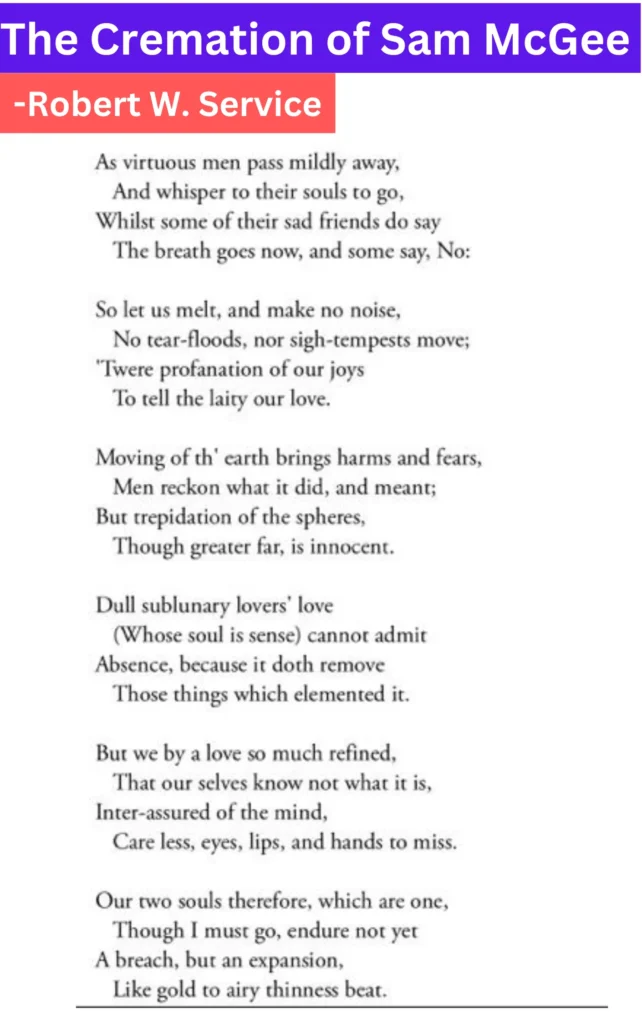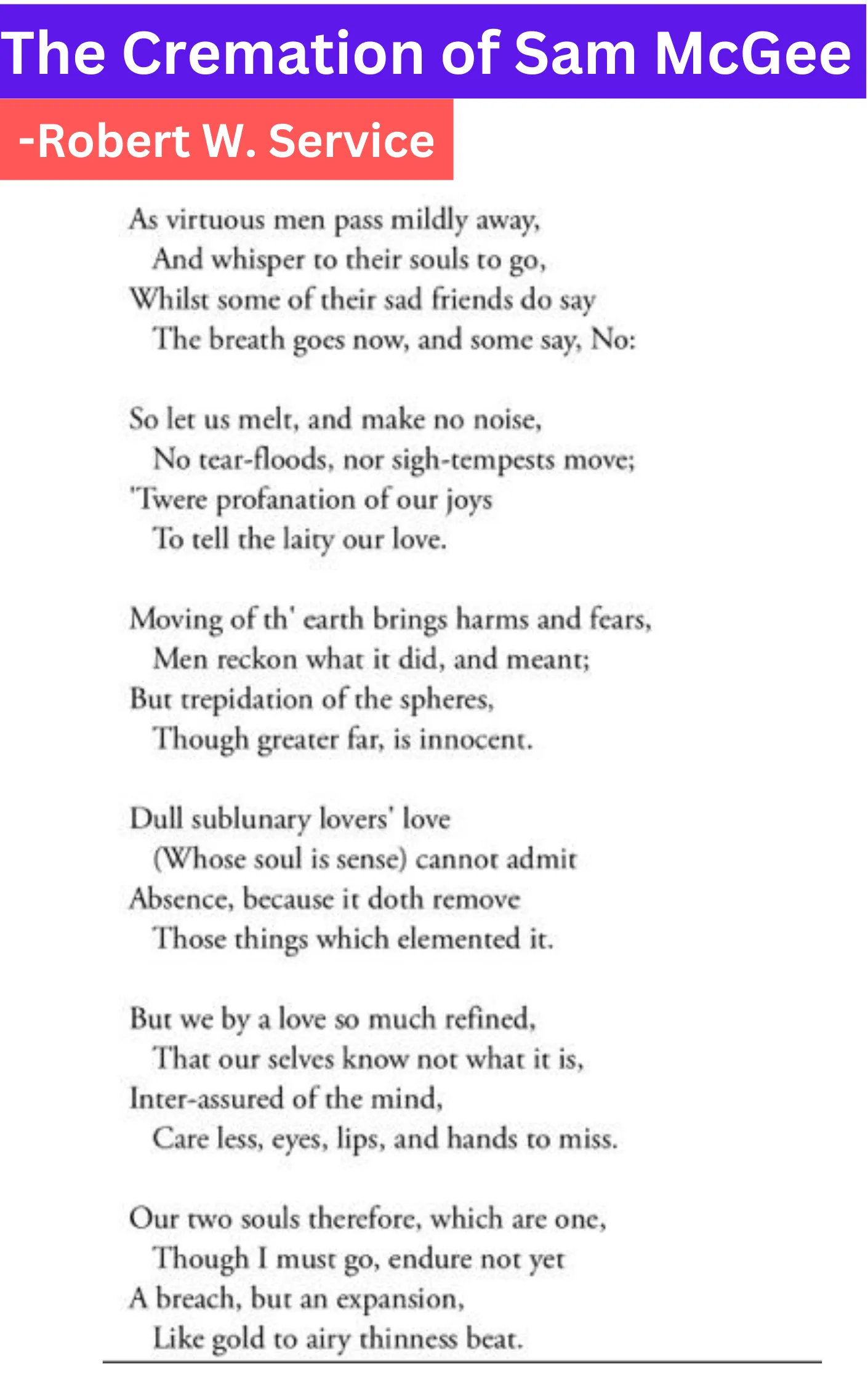
About Poem- A Valediction: Forbidding Mourning
| Poem Title | A Valediction: Forbidding Mourning |
| Author | John Donne |
| Date of Writing | Early 17th century (published in 1633) |
| Genre | Metaphysical poetry |
| Style | Metaphysical conceit, elaborate metaphors |
| Form | Lyric poem with three stanzas |
| Themes | True love, constancy, spiritual connection, balanced relationships, absence and reunion |
| Metaphor | Compass as a symbol of love |
| Tone | Reflective, celebratory, and profound |
| Publication | First published in “Songs and Sonnets” |
| Key literary devices | Metaphor, simile, and personification |
| Structure | Each stanza has nine lines with varying rhyme schemes |
| Famous lines | If they be two, they are two so As stiff twin compasses are two; Thy soul, the fixed foot, makes no show To move, but doth, if th’ other do. |
Themes- A Valediction: Forbidding Mourning
The themes of “A Valediction: Forbidding Mourning” by John Donne are
- True Love ➤ The poem explores the idea of love that’s deep and enduring.
- Steadfastness ➤ It celebrates love’s constancy and unwavering nature.
- Spiritual Connection ➤ The poem suggests that love goes beyond the physical and is almost spiritual.
- Balanced Relationships ➤ It discusses how two people can be separate but still connected.
- Absence and Reunion ➤ It focuses on how temporary separation can strengthen love, not weaken it.
- Elegy and Farewell ➤ The poem offers a positive view of parting, unlike traditional sad farewells.
A Valediction: Forbidding Mourning Poem
As virtuous men pass mildly away,
And whisper to their souls to go,
Whilst some of their sad friends do say
The breath goes now, and some say, No:
So let us melt, and make no noise,
No tear-floods, nor sigh-tempests move;
‘Twere profanation of our joys
To tell the laity our love.
Moving of th’ earth brings harms and fears,
Men reckon what it did, and meant;
But trepidation of the spheres,
Though greater far, is innocent.
Dull sublunary lovers’ love
(Whose soul is sense) cannot admit
Absence, because it doth remove
Those things which elemented it.
But we by a love so much refined,
That our selves know not what it is,
Inter-assured of the mind,
Care less, eyes, lips, and hands to miss.
Our two souls therefore, which are one,
Though I must go, endure not yet
A breach, but an expansion,
Like gold to airy thinness beat.
If they be two, they are two so
As stiff twin compasses are two;
Thy soul, the fixed foot, makes no show
To move, but doth, if the other do.
And though it in the center sit,
Yet when the other far doth roam,
It leans and hearkens after it,
And grows erect, as that comes home.
Such wilt thou be to me, who must,
Like th’ other foot, obliquely run;
Thy firmness makes my circle just,
And makes me end where I begun.
A Valediction: Forbidding Mourning Summary & Analysis
A Valediction: Forbidding Mourning” by John Donne is a metaphysical poem that intricately explores the theme of love and separation. The poem is composed of nine quatrains, each with a distinct thematic focus. Here’s a stanza-wise summary of this remarkable poem:
Stanza 1
In the opening stanza, the speaker acknowledges the necessity of parting from his beloved but urges her not to mourn their separation. He likens their love to a virtuous and spiritual kind that is not weakened by physical distance.
Stanza 2
The second stanza employs a compass as a metaphor for their love. The speaker argues that their souls are like the legs of a compass—while one travels, the other remains fixed at the center. This symbolizes the idea that their love remains constant and unwavering even when physically apart.
Stanza 3
In the third stanza, the speaker describes how virtuous love should not be affected by external circumstances. Just as gold is not diminished by being stretched into a thin wire, their love remains undiminished by separation.
Stanza 4
The fourth stanza continues to elaborate on the idea of spiritual, ethereal love. The speaker emphasizes the purity and strength of their love by comparing it to heavenly bodies that move in perfect, harmonious orbits.
Stanza 5
In the fifth stanza, the speaker acknowledges that earthly, sensual love may be disturbed by separation, but their love is beyond such concerns. He suggests that their separation is merely a temporary physical distance that can’t alter the deep connection of their souls.
Stanza 6
The sixth stanza reinforces the notion that their love is unique and extraordinary. It’s not the ordinary, passionate love of the world, but a love that transcends the physical realm and exists on a spiritual plane.
Stanza 7
The seventh stanza presents a vivid and touching image of the departing lover as he compares himself to a dying man, urging his beloved to hold her tears and emotions back, just as a dying man peacefully breathes his last.
Stanza 8
The eighth stanza brings the metaphor of the compass back, explaining that when they are reunited, their love will be even more profound and complete, like the joining of the compass legs at the center.
Stanza 9
In the final stanza, the poem concludes with the idea that their love will become stronger through their time apart. The parting is only a temporary physical separation, and it deepens their spiritual bond. The speaker assures his beloved that they will be together again and that their love is everlasting.
FAQs- A Valediction: Forbidding Mourning
What is the message of A Valediction: Forbidding Mourning?
The message of “A Valediction: Forbidding Mourning” is that true love transcends physical separation and even death.
What is the metaphor in A Valediction: Forbidding Mourning?
The metaphor is that love is like a compass.
What does a valediction of weeping symbolize?
A valediction of weeping symbolizes the pain and sorrow of separation, but also the hope and belief that love can transcend physical distance.
What did the speaker explicitly want death to do at the end?
The speaker wanted death to leave him and his wife together, just as the two legs of a compass are always together.
What is A Valediction: Forbidding Mourning by John Donne addressed to?
This poem by John Donne is addressed to his wife.
What is the conclusion of A Valediction: Forbidding Mourning?
The poem ends with the speaker saying that their love is so strong that it doesn’t matter if they are apart, because their souls are always connected.










![The Catcher In The Rye Summary, Themes & Characters [by J. D. Salinger] The Catcher In The Rye Summary, Themes & Characters [by J. D. Salinger]](https://atozsummary.com/wp-content/uploads/2023/06/The-Catcher-In-The-Rye-Summary-Themes-Characters-by-J.-D.-Salinger.webp)
